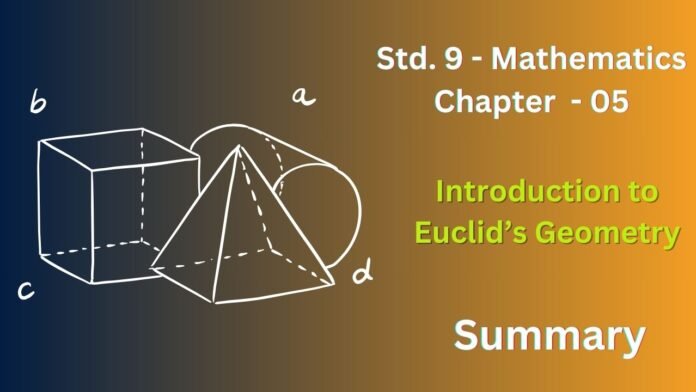Euclid’s Geometry is the foundational branch of mathematics that deals with the properties of shapes and spaces. It’s based on a set of axioms and postulates, which are fundamental assumptions without proof.
Key Concepts
- Undefined Terms: Basic terms like point, line, and plane that are understood intuitively but not formally defined.
- Axioms: General statements accepted without proof, forming the foundation of geometry.
- Postulates: Specific assumptions related to geometry. Euclid proposed five postulates.
- Theorems: Statements that can be proven based on axioms, postulates, and previously proven theorems.
Exercise 5.1
1. Which of the following statements are true and which are false? Give reasons for your answers.
(i) Only one line can pass through a single point.
(ii) There are an infinite number of lines which pass through two distinct points.
(iii) A terminated line can be produced indefinitely on both the sides.
(iv) If two circles are equal, then their radii are equal.
(v) In figure, if AB – PQ and PQ = XY, then AB = XY.
Ans :
i) True.
This is a fundamental geometric concept. A point is infinitely small and a line is infinitely long. Therefore, only one straight line can pass through a given point.
ii) False.
Only one straight line can pass through two distinct points.
iii) True.
This is one of Euclid’s postulates.
iv) True.
Equal circles have the same radius by definition.
v) True.
This is a transitive property of equality.
2. Give a definition for each of the following terms. Are there other terms that need to be defined first? What are they and how might you define them?
(i) Parallel lines
(ii) Perpendicular lines
(iii) Line segment
(iv) Radius of a circle
(v) Square
Ans :
i) Parallel lines
- Two lines in a plane that never intersect each other, no matter how far they are extended.
ii) Perpendicular lines
- Two lines that intersect each other at a right angle (90 degrees).
iii) Line segment
- A line segment is a portion of a line that is defined by two distinct endpoints.
iv) Radius of a circle
- A line segment joining the center of a circle to any point on its circumference.
v) Square
- A quadrilateral where all sides are of equal length and each angle is a right angle.
3. Consider two ‘postulates’ given below
(i) Given any two distinct points A and B, there exists a third point C which is in between A and B.
(ii) There exist atleast three points that are not on the same line.
Do these postulates contain any undefined terms? Are these postulates consistent? Do they follow from Euclid’s postulates? Explain.
Ans :
(i) states that for two points A and B, there is a point C on the line between them. In contrast,
(ii) states that for points A and B, point C can be chosen such that it does not lie on the line passing through A and B.
No, these postulates do not directly follow from Euclid’s postulates, but they do follow from the axiom, “Given two distinct points, there is exactly one line that passes through them.”
4. If a point C lies between two points A and B such that AC = BC, then prove that AC = 1/2 AB, explain by drawing the figure.
Ans :
Given:
- Point C lies between points A and B.
- AC = BC
To Prove:
- AC = 1/2 AB
Proof:
line segment AB with point C between A and B
- Given: AC = BC
- Adding AC to both sides of the equation: AC + AC = BC + AC
- Simplifying the left side: 2AC = BC + AC
- Since BC and AC together form AB, we can substitute AB for BC + AC: 2AC = AB
- Dividing both sides by 2: AC = 1/2 AB
Therefore, AC = 1/2 AB.
This proves that if a point C lies between two points A and B such that AC = BC, then AC is half the length of AB.
5. In question 4, point C is called a mid-point of line segment AB. Prove that every line segment has one and only one mid-point.
Ans :
AC = 12AB ……(i)
and AD = 12AB ……(ii)
Subtracting (i) from (ii), we have
AD – AC = 12AB−12AB
or AD – AC = 0
or CD = 0
∴ C and D coincide.
6. In figure, if AC = BD, then prove that AB = CD.
Ans :
We are given a line segment AD with points B and C lying on it. We are also given that AC = BD.
Proof:
- Given: AC = BD
- Observation: We can express AD in two ways: AD = AB + BC and AD = BC + CD
- Equating the two expressions for AD: AB + BC = BC + CD
- Subtracting BC from both sides: AB + BC – BC = BC + CD – BC
- Simplifying: AB = CD
Therefore, AB = CD.
7.Why is axiom 5, in the list of Euclid’s axioms, considered a ‘universal truth’? (Note that, the question is not about the fifth postulate.)
Ans : This axiom reflects our basic intuition about quantity and is so fundamental that it is difficult to imagine a scenario where it would not hold true.
Therefore, it is classified as a universal truth.


